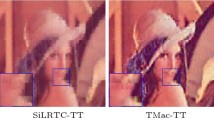Abstract
Tensor train is one of the modern decompositions used as low-rank tensor approximations of multidimensional arrays. If the original data is nonnegative we sometimes want the approximant to keep this property. In this work new methods for nonnegative tensor train factorization are proposed. Low-rank approximation approach helps to speed up the computations whereas DMRG technique allows to adapt nonnegative TT ranks for better accuracy. The performance analysis of the proposed algorithms as well as comparison with other nonnegative TT factorization method are presented.
Similar content being viewed by others
References
I. Oseledets, “Tensor-Train Decomposition,” SIAM J. Sci. Comput. 33, 2295–2317 (2011).
I. Oseledets and E. Tyrtyshnikov, “TT-cross approximation for multidimensional arrays,” Linear Algebra Appl. 432, 70–88 (2010)
N. Lee, A. Phan, F. Cong, and A. Cichocki, “Nonnegative tensor train decompositions for multi-domain feature extraction and clustering,” Lect. Notes Comput. Sci. 9949, 87–95 (2016).
D. Lee and H. Seung, “Learning the parts of objects by nonnegative matrix factorization,” Nature (London, U.K.) 401, 788–791 (1999).
D. Lee and H. Seung, “Algorithms for non-negative matrix factorization,” Adv. Neural Inform. Process. Syst. 13 (2001).
S. Vavasis, “On the complexity of nonnegative matrix factorization,” SIAM J. Optimiz. 20, 1364–1377 (2007).
J. Cohen and U. Rothblum, “Nonnegative ranks, decompositions and factorizations of nonnegative matrices,” Linear Algebra Appl. 190, 149–168 (1993).
G. Zhou, A. Cichocki, and S. Xie, “Fast nonnegative matrix/tensor factorization based on low-rank approximation,” IEEE Trans. Signal Process. 60, 2928–2940 (2012).
S. Goreinov, E. Tyrtyshnikov, and N. Zamarashkin, “A theory of pseudo-skeleton approximations,” Linear Algebra Appl. 261, 1–21 (1997).
E. Tyrtyshnikov, “Incomplete cross approximation in the mosaic-skeleton method,” Computing 64, 367–380 (2000).
S. Goreinov and E. Tyrtyshnikov, “The maximal-volume concept in approximation by low-rank matrices,” Contemp. Math. 208, 47–51 (2001).
S. Goreinov, I. Oseledets, D. Savostyanov, E. Tyrtyshnikov, and N. Zamarashkin, “How to find a good submatrix,” in Matrix Methods: Theory, Algorithms and Applications (World Scientific, Singapore, 2010), pp. 247–256.
I. Oseledets et al., TT-Toolbox (TT=Tensor Train), Vers. 2.2.2 (Inst. Numerical Mathematics, Moscow, 2009–2013). https://github.com/oseledets/TT-Toolbox.
TDALAB-MATLAB Toolbox for High-order Tensor Data Decompositions and Analysis. Current Vers. 1.1 (2013). https://github.com/andrewssobral/TDALAB.
F. Cong, Q.-H. Lin, L.-D. Kuang, X.-F Gong, P. Astikainen, and T. Ristaniemi, “Tensor decomposition of EEG signals: a brief review,” J. Neurosci. Methods 248, 59–69 (2015).
F. Cong, A. Phan, Q. Zhao, T. Huttunen-Scott, J. Kaartinen, T. Ristaniemi, H. Lyytinen, and A. Cichocki, “Benefits of multi-domain feature of mismatch negativity extracted by nonnegative tensor factorization from low-density array EEG,” Int. J. Neural Syst. 22 (6) (2012).
E. Tyrtyshnikov and E. Shcherbakova, “Nonnegative tensor train factorizations and some applications,” Lect. Notes Comput. Sci. (in press).
D. Savostyanov and I. Oseledets, “Fast adaptive interpolation of multi-dimensional arrays in tensor train format,” in Proceedings of the 7th International Workshop on Multidimensional (nD) Systems, nDS 2011 (2011), pp. 1–8.
E. Tyrtyshnikov and E. Shcherbakova, “Nonnegative matrix factorization methods based on low-rank cross approximations,” Comput. Math. Math. Phys. 59 (8) (2019, in press).
Acknowledgments
The author thanks E. E. Tyrtyshnikov for useful advices and participation in discussions of the results.
Funding
This article contains the results of the project performed in the framework of the implementation of the programs of the Central Competences of the National Technological Database “Center for Big Data Storage and Analysis” (project “Tensor methods for processing and analysis of Big Data”) of Lomonosov MSU with the Project Support Funding of the National Technological Reporting dated December 11, 2018, no. 13/1251/2018.
Author information
Authors and Affiliations
Corresponding author
Additional information
Submitted by Vl. V. Voevodin
Rights and permissions
About this article
Cite this article
Shcherbakova, E.M. Nonnegative Tensor Train Factorization with DMRG Technique. Lobachevskii J Math 40, 1863–1872 (2019). https://doi.org/10.1134/S1995080219110283
Received:
Revised:
Accepted:
Published:
Issue Date:
DOI: https://doi.org/10.1134/S1995080219110283




